Today’s Current Affairs: 8th April 2025 for UPSC IAS exams, State PSC exams, SSC CGL, State SSC, RRB, Railways, Banking Exam & IBPS, etc
Table of Contents
University Grants Commission : In News

The University Grants Commission (UGC) has notified the “Recognition and Grant of Equivalence to Qualifications Obtained from Foreign Educational Institutions Regulations, 2025”.
- These regulations were finalised after public feedback on the 2023 draft and aim to provide a transparent, structured, and standardised process for recognising foreign academic qualifications.
- This move aligns with the National Education Policy (NEP) 2020, which emphasises the internationalisation of Indian higher education and the need to seamlessly integrate international students and returning Indian students into India’s education and employment systems.
What are Equivalence Certificates? - An equivalence certificate is an official document that certifies a foreign qualification (degree/diploma/certificate) as equivalent to a corresponding Indian qualification.
- These certificates are now to be issued by the UGC, replacing the previous system managed by the Association of Indian Universities (AIU).
River Blindness:
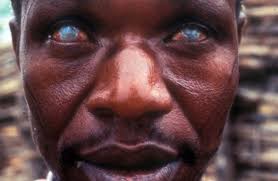
Zoological Survey of India (ZSI) study on blackflies offers hope for river blindness control, Researchers worked on four species collected from eight locations in the central Himalayan region
- A new study by the Zoological Survey of India (ZSI) has introduced DNA barcoding to accurately identify blackfly species—the carriers of Onchocerca volvulus, the parasitic worm that causes river blindness (onchocerciasis).
- This innovation is expected to enhance disease control and vector management, especially in vulnerable ecological zones like the central Himalaya
- River blindness is a neglected tropical disease (NTD) caused by the parasitic worm Onchocerca volvulus.
- The disease is transmitted to humans through the bite of infected blackflies belonging to the genus Simulium, which breed in fast-flowing rivers and streams.
- Symptoms include intense skin itching, disfiguring skin changes, and in advanced cases, permanent vision loss or blindness.
- Globally, it is second only to trachoma in causing infection-related blindness, especially affecting rural populations in sub-Saharan Africa, Yemen, and parts of Latin America.
- Treatment relies on Mass Drug Administration (MDA) using ivermectin, with a minimum 80% therapeutic coverage required for effective control.
- According to the World Health Organization (WHO), river blindness remains one of the most neglected tropical diseases, especially in remote and rural areas
Hadean Protocrust:

A new international study led by Macquarie University, Australia, suggests that the chemical signatures attributed to plate tectonics were already present in the Hadean protocrust.
- The Hadean protocrust refers to the earliest known crust of the Earth—its outermost solid layer—that formed during the Hadean aeon, the planet’s first geologic era, which began around 6 billion years ago.
- This period is named after ‘Hades’, the Greek god of the underworld, due to the extremely hot, hostile, and unstable conditions that prevailed on early Earth.
- The Earth, within its first 200 million years, had a surface that was partially molten, with widespread volcanic activity and constant meteorite bombardment from space.
- During this time, the magma ocean—a vast reservoir of molten rock covering Earth’s surface—began to cool gradually.
- As the surface cooled, early fragments of solid crust began to form. These fragments were not stable and often broke off, while new layers solidified, creating a flaky, unstable crustal layer.
- Some thicker segments of this primitive crust eventually consolidated into the first proto-continents, floating on the underlying asthenospheric mantle—a semi-fluid layer extending up to 400 km beneath the surface.
- As these crustal plates drifted across the mantle, they began to interact in various ways: colliding, sliding past, or subducting (diving under) one another.
- These early plate movements laid the foundation for plate tectonics, a key process in shaping the Earth’s geological features.
- Over time, these interactions left distinct chemical signatures in the Earth’s crust, enabling scientists to reconstruct the history of tectonic activity.
Long-snouted Vine Snake:
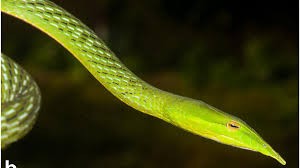
A rare long-snouted vine snake (Ahaetulla longirostris) was rediscovered in Dudhwa Tiger Reserve, Uttar Pradesh during a rhino release operation in the Palia Kheri division.
- This marks the first recorded sighting in Uttar Pradesh and only the second documented instance in India.
- The species was previously seen only in Valmiki Tiger Reserve, Bihar, and some parts of Odisha, with its natural range usually in Southeast Asia.
- Ahaetulla longirostris belongs to the Colubridae family, which includes mostly non-venomous snakes.
- It has a long, slender body that is typically bright green or brown, helping it to camouflage in foliage.
- A distinctive elongated snout (rostral extension) differentiates it from other vine snakes.
- It is an arboreal species, living on trees and easily blends with leaves and branches.
- It is mildly venomous, but not dangerous to humans.
- Dudhwa Tiger Reserve located on the Indo-Nepal border in Lakhimpur Kheri district, Uttar Pradesh.
- The reserve includes Dudhwa National Park, Kishanpur Wildlife Sanctuary, Katarniaghat Wildlife Sanctuary, and forest areas of North Kheri, South Kheri, and Shahjahanpur.
- It lies within the Tarai-Bhabar zone of the Upper Gangetic Plains Biogeographic Province.
Semaglutide:

A recent international, multicentre clinical study has found that semaglutide, a medication primarily used to treat type 2 diabetes and obesity, can reduce the risk of major cardiovascular events by 14%.
- Semaglutide is a glucagon-like peptide-1 receptor agonist (GLP-1 RA).
- It mimics GLP-1, a natural hormone that helps regulate blood sugar and appetite.
- It is used to:
- Treat type 2 diabetes by enhancing insulin secretion and lowering blood sugar levels.
- Aid weight loss in overweight or obese individuals, along with proper diet and exercise.
- It is available in two forms: injectable and oral tablets. The SOUL trial specifically tested the oral version, known as Rybelsus (by Novo Nordisk).
- The SOUL trial, launched in 2019, was a phase three, double-blind, randomised, placebo-controlled study designed to assess whether oral semaglutide can lower the incidence of major adverse cardiovascular events (MACE) in people with type 2 diabetes (T2DM) who also suffer from cardiovascular disease (CVD) or chronic kidney disease (CKD).
- The primary composite endpoint of the trial was a reduction in cardiovascular death, non-fatal heart attacks (myocardial infarction), and non-fatal strokes.
- The results revealed a statistically significant 14% reduction in the risk of such cardiovascular events in patients using oral semaglutide as compared to those receiving a placebo, alongside standard care.
Balukhand-Konark Wildlife Sanctuary:
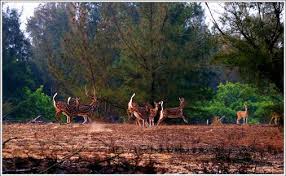
A recent study found that dense vegetation in Balukhand-Konark Wildlife Sanctuary, home to spotted deer and blackbucks, has shrunk from 41.8% in 1993 to 37.1% in 2023.
- Balukhand-Konark Wildlife Sanctuary is located in Puri district, Odisha.
- It was declared a sanctuary on 23 April 1984.
- It has an area of 87 sq.km.
- It was established on the sandy tract covered by plantation of casurina and cashew trees, along the coast between Puri and Konark.
- It is traversed by the rivulets such as Nuanai River, Kusabhadra River, Kadua River, and Prachi River.
- Apart from cashew and casurina plantation, Australian acacia and eucalyptus plantations has also been done.
- Jamun, ficus, neem, karanj, and polang trees are also found, mostly along the course of the Kusabhadra and Nuanai rivers.
- It is home to herds of herbivores (spotted deer), monkeys, jungle cat, hyena, monitor lizard, snakes, etc.
- Olive Ridley sea turtles have been seen nesting on the beach.
Woolly Flying Squirrel:
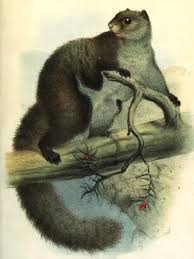
The wildlife wing of Himachal Pradesh Forest Department (HPFD) recently captured the first-ever photographic evidence of the elusive Woolly Flying Squirrel at Miyar Valley in Lahaul and Spiti district.
- Woolly Flying Squirrel, also known as Western Woolly Flying Squirrel, is one of the rarest and least known mammals in Asia.
- It is endemic to the northwestern Himalayas.
- Scientific Name: Eupetaurus cinereus
- It is the sole species of the genus Eupetaurus.
- It was long believed to be extinct until its rediscovery in 1994 — nearly after seventy years.
- It appears to live in a fragmented habitat within a very limited area in a thin elevational band of dry conifer woodland.
- It is native to northern Pakistan and northwestern India.
- Like other flying squirrels, it has elastic membranes on each side of the body connecting the fore and hind legs.
- Conservation Status: IUCN Red List: Endangered
Maternal Mortality 2000-2023 Report:
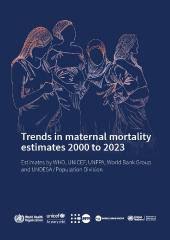
In 2023, India accounted for the second highest maternal deaths globally, tied with the Democratic Republic of Congo (DRC) with 19,000 and second only to Nigeria, according to the Trends in Maternal Mortality 2000-2023 report released recently.
- It is a new report from the United Nations Maternal Mortality Estimation Inter-Agency Group (MMEIG), comprising WHO, UNICEF, UNFPA, the World Bank Group, and the UN Department of Economic and Social Affairs (UNDESA/population division).
- It presents the most up-to-date, internationally comparable estimates of maternal deaths at global, regional, and country levels.
Highlights of the Report:
- In 2023, an estimated 260,000 maternal deaths occurred worldwide, equivalent to 712 deaths each day.
- This marks a 40% reduction in maternal mortality since 2000, reflecting sustained global efforts to improve access to essential health services.
- For the first time, no country was estimated to have an extremely high maternal mortality ratio (MMR), and no region was classified as having a very high MMR.
- Despite these gains, disparities remain stark. Sub-Saharan Africa accounted for 70% of global maternal deaths, with Central and Southern Asia contributing nearly 17%.
- In 2023, 37 countries were classified as being in conflict or experiencing institutional or social fragility, yet they accounted for 64% of global maternal deaths.
- Nigeria had the highest number of maternal deaths and accounted for more than a quarter (28.7 percent) of all estimated global maternal deaths in 2023, with approximately 75,000 deaths.
- Only three other countries had more than 10,000 maternal deaths in 2023—India, the Democratic Republic of the Congo, and Pakistan (11,000).
- India and DRC accounted for 7.2 percent each, while Pakistan accounted for 4.1 percent of global maternal deaths.
- Together, these four countries accounted for almost half (47 percent) of all maternal deaths globally in 2023.
- China, the only other country on the planet comparable to India by population, registered just 1,400 maternal deaths in 2023.
- The statistics reveal that India’s MMR—or the rate at which women per lakh die due to childbirth or pregnancy-related issues—was 362 in 2000 and came down to 80 in 2023, marking a decline of 78 percent over the period.
- The report also provides the first global account of the COVID-19 pandemic’s impact on maternal survival.
- In 2021, when the second wave of COVID was at its peak in most parts of the world, an estimated 40,000 more women died due to pregnancy or childbirth, taking the total number of deaths that year to 3,22,000 from 282,000 the previous year.
- Haemorrhage is a direct obstetric cause of death and remains the leading cause of maternal mortality globally.
Women and Men in India 2024: Selected Indicators and Data

Ministry of Statistics and Programme Implementation (MoSPI), Government of India, recently released the 26th edition of its publication titled “Women and Men in India 2024: Selected Indicators and Data”.
- It is published by the Ministry of Statistics and Programme Implementation (MoSPI), Government of India.
- It offers a comprehensive overview of the gender landscape in India, presenting selected indicators and data across key areas like population, education, health, economic participation, and decision-making, all sourced from various Ministries/ Departments/Organizations.
- Utilizing official statistics, it presents gender-disaggregated data across urban-rural divides and geographic regions, facilitating a nuanced understanding of the challenges and opportunities faced by women and men.
Highlights of the 2024 Report:
- Gender Parity Index (GPI) for enrolments at the primary and higher secondary was higher in FY24 than in FY23 and FY22, meaning more girls are being enrolled now.
- At upper primary and elementary levels, the enrolment numbers were more or less the same for boys and girls.
- The Labour Force Participation Rate (LFPR) for women aged 15 and above improved significantly, rising from 49.8% in 2017-18 to 60.1% in 2023-24.
- In the financial sector, women own 39.2% of all bank accounts and contribute to 7% of total deposits, with their presence most prominent in rural areas, where they account for 42.2% of account holders.
- Female participation in the capital market is also growing, but overall numbers are small.
- Between March 2021 and November 2024, the number of DEMAT accounts surged from 33.26 million to 143.02 million. Of these, the number of women account holders rose from 6.67 million in 2021 to 27.71 million in 2024.
- A rising percentage of female-headed proprietary establishments across manufacturing, trade, and other services sectors over the years 2021-22, 2022-23, and 2023-24 has been observed.
- The number of male and female voters grew from 173.2 million in 1952 to 978 million in 2024, with an increasing share of females.
- In the 2024 general elections, female voter turnout (65.8%) surpassed male turnout, even as it dipped slightly from 67.2% in 2019.
- Female entrepreneurship is also on the rise.
- The number of startups recognized by DPIIT with at least one woman director rose sharply from 1,943 in 2017 to 17,405 in 2024.
World Health Day 2025:
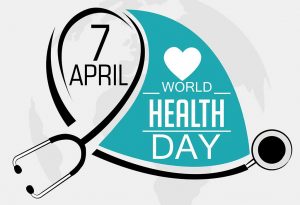
Every year on April 7, World Health Day is observed to increase global awareness of a varied range of health-related concerns.World Health Day is observed on April 07 every year.
- This day marks the anniversary of the founding of the World Health Organization (WHO) in 1948 and has been celebrated since 1950. .
- Each year, World Health Day is used as an opportunity to draw attention to a specific health topic that affects people all over the world.
- By emphasizing one particular theme every year, World Health Day encourages governments, healthcare organisations, and individuals to work collectively toward improving health standards and access to healthcare.
- The theme for World Health Day 2025 is ‘Healthy beginnings, hopeful futures.’
- This year’s theme will kick off a year-long campaign on maternal and newborn health.
- This initiative will encourage governments and the healthcare sector to intensify their actions to eliminate preventable maternal and newborn deaths.
- It will also focus on the long-term health and well-being of women.
- The campaign will aim to promote information and strategies that can help support healthy pregnancies and births, and better postnatal health.
Ice Stupas – Artificial Glacier:
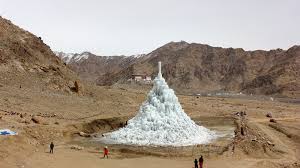
Farmers in Gilgit-Baltistan region have successfully used ice stupas, inspired by Ladakhi engineer Sonam Wangchuk, to overcome water shortages.
- Ice stupas are artificial glaciers shaped like cones that store winter water in frozen form.
- Named after Buddhist stupas due to their iconic dome-like shape.
- Water is diverted from nearby glacial streams using gravity-driven pipelines, eliminating the need for pumps or electricity.
- At sub-zero temperatures during winter nights, water is sprayed vertically into the air, where droplets freeze mid-air and settle over a support frame.
- The ice accumulates into a cone-shaped structure (stupa), which reduces sunlight exposure and insulates the core, minimizing early melting.
- In spring, the stupa melts gradually from top to bottom, releasing water slowly to irrigate crops like apples, apricots, wheat, and barley.
- The process uses phase change, latent heat storage, heat transfer, and hydraulic gradient to create a natural, low-cost water storage solution.
CAPTCHA Systems:

CAPTCHA systems are once again in focus as debates arise over their role in the recent surge of bot activity and digital security breaches, highlighting both their importance and limitations in today’s evolving cyber landscape.
- CAPTCHA stands for “Completely Automated Public Turing test to tell Computers and Humans Apart.”
- It is a human verification tool designed to distinguish between real users and automated bots.
- Users are prompted to solve puzzles, like identifying distorted text or selecting images (e.g., traffic lights or cars).
- reCAPTCHA, introduced in 2009, used scanned words from books to aid in digitization.
- Invisible reCAPTCHA (2014) detects human presence using mouse movement and user behaviour.
- CAPTCHA Protects websites from spam, fake registrations, and automated attacks.
- Adds a security layer to sensitive actions like logins, payments, and data recovery.
- Used in online forms, comment sections, polls, and e-commerce for human validation.
- Supported by major tech players, including Google, and deployed across thousands of platforms.
Project Varsha:

India is set to commission its first dedicated nuclear submarine base, INS Varsha, in Andhra Pradesh in 2026, as part of Project Varsha, and plans to operationalise its third nuclear-powered submarine, INS Aridhaman.
- Project Varsha A classified naval infrastructure project launched by the Indian Navy to build INS Varsha, a state-of-the-art nuclear submarine base.
- Located near Rambilli, about 50 km south of Visakhapatnam in Andhra Pradesh.
- Aim is to enhance India’s maritime strike capabilities in the Bay of Bengal and Indian Ocean Region (IOR).
- Acts as a counterbalance to China’s strategic expansion in the region.
- Underground submarine pens and tunnels for stealth deployment.
- Capacity to dock up to 12 nuclear submarines.
- Provides protection from aerial surveillance and satellite detection.
- Built near BARC Atchutapuram, enabling access to advanced nuclear infrastructure.
- Ensures rapid submarine access to key chokepoints like the Strait of Malacca.
- Counters China’s dual-use naval facilities like Hambantota (Sri Lanka) and BNS Sheikh Hasina (Bangladesh).
- Enhances India’s second-strike capability under the nuclear triad.
Coastal Shipping Bill, 2024 and the Protection of Interest in Aircraft Objects Bill, 2025:
The Lok Sabha has passed two key legislations- the Coastal Shipping Bill, 2024 and the Protection of Interest in Aircraft Objects Bill, 2025 aimed at strengthening the coastal shipping and aviation sector.It aims to promote cost-effective and sustainable coastal trade, by increasing coastal shipping’s freight share from the current 5% (vs 40% in the EU) by reducing over-reliance on roadways (66%) and railways (31%), thereby lowering logistics costs, traffic congestion, and pollution.
Pondicherry Heritage Festival 2025:
The 11th edition of the Pondicherry Heritage Festival kicked off with a vibrant display of culture, history, and community spirit in Puducherry’s Tamil Quarter. The event, marked by the ‘Veedhi Vilayattu’ (Street Games), took place along a stretch between Easwaran Koil and Anna Salai, transforming the area into a lively playground. Children had the chance to experience and engage in traditional games from the past, while the community came together to celebrate their heritage. The festival brought the streets to life with traditional activities, food, and fun, successfully engaging more than 250 children and numerous residents.
Government Set To Implement “One State, One RRB”:
The Indian government is set to implement the “One State, One RRB” (Regional Rural Bank) policy to improve operational efficiency, reduce competition, and consolidate the existing 43 RRBs into 28. The Ministry of Finance aims to streamline the functioning of these banks by merging smaller, less efficient ones, with the goal of enhancing their service delivery and cost-effectiveness. This initiative, which is part of a larger consolidation effort, builds on the previous rounds of RRB amalgamation that reduced their numbers from 196 to 43. The policy is expected to improve credit flow, particularly in rural areas, by strengthening RRBs’ financial positions and operational frameworks.
Excise Duty Hiked on Petrol and Diesel:
Central Government of India announced an increase in excise duties on petrol and diesel by ₹2 per litre each. According to a notification by the Revenue Department under the Ministry of Finance, the new excise duty on petrol is now ₹13/litre and ₹10/litre on diesel. Despite the duty hike, the Ministry of Petroleum and Natural Gas has confirmed that there will be no change in retail prices, as public sector oil marketing companies (OMCs) will absorb the increase. The change comes against the backdrop of global oil price fluctuations, triggered by the US’s tariff policies and increased output by OPEC+.
GI Tags for Nolen Gurer Sandesh:
West Bengal has achieved a significant milestone in preserving and promoting its cultural heritage by securing Geographical Indication (GI) tags for seven new products, including the iconic Nolen Gurer Sandesh and Baruipur guavas. This recognition will provide global recognition to these traditional items, boosting the state’s local economy and enhancing its cultural identity. These GI tags highlight West Bengal’s rich heritage, spanning from sweets and agriculture to textiles and handicrafts. The newly tagged products include some well-known regional delicacies like Nolen Gurer Sandesh, a sweet made with date palm jaggery, and Kamarpukur’s white ‘bonde’.
Kazakhstan’s Major Rare Earth Elements Are Discovered:
Kazakhstan has uncovered its largest-ever reserve of rare earth metals at the Kuirektykol site in the Karaganda region, marking a transformative moment for the country’s mining industry and its position on the global resource map. With nearly one million tons of rare earth elements (REEs) and potential reserves exceeding 20 million tons in the broader Zhana Kazakhstan zone, this discovery could position Kazakhstan as a major player in the critical minerals sector. As the world races toward green technology and reduced dependence on dominant suppliers like China, Kazakhstan’s find could not be more timely.
Kancha Gachibowli Land Controversy Protest:
The auction of 400 acres of forested land in Kancha Gachibowli, Hyderabad, has sparked widespread protests, particularly among students of the University of Hyderabad. The Telangana government’s decision to monetize the land, which lies adjacent to the university, has raised serious concerns over environmental degradation, land ownership disputes, and a lack of proper ecological assessments. The issue has now drawn the attention of both the Telangana High Court and the Supreme Court, which have intervened in the matter.




